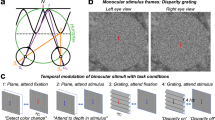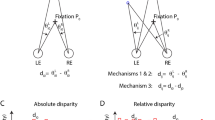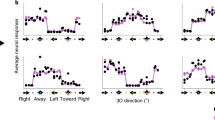Abstract
Our two eyes obtain slightly different views of the world. The resulting differences in the two retinal images, called binocular disparities, provide us with a stereoscopic sense of depth1. The primary visual cortex (V1) contains neurons that are selective for the disparity2,3,4 of individual elements in an image, but this information must be further analysed to complete the stereoscopic process5,6. Here we apply the psychophysical technique of reverse correlation7 to investigate disparity processing in human vision. Observers viewed binocular random-dot patterns, with ‘signal’ dots in a specific depth plane plus ‘noise’ dots with randomly assigned disparities. By examining the correlation between the observers' ability to detect the plane and the particular sample of ‘noise’ disparities presented on each trial, we revealed detection ‘filters’, whose disparity selectivity was remarkably similar to that of individual neurons in monkey V1. Moreover, if the noise dots were of opposite contrast in the two eyes, the tuning inverted, just like the response patterns of V1 neurons5,6. Reverse correlation appears to probe disparity processing at the earliest stages of binocular combination, prior to the generation of a full stereoscopic depth percept.
This is a preview of subscription content, access via your institution
Access options
Subscribe to this journal
Receive 51 print issues and online access
$199.00 per year
only $3.90 per issue
Buy this article
- Purchase on Springer Link
- Instant access to full article PDF
Prices may be subject to local taxes which are calculated during checkout



Similar content being viewed by others
References
Wheatstone,C. Contributions to the physiology of vision—Part the first. On some remarkable and hitherto unobserved phenomena of binocular vision. Phil. Trans. R. Soc. 128, 371–394 ( 1838).
Barlow,H. B., Blakemore,C. & Pettigrew, J. D. The neural mechanism of binocular depth discrimination. J. Physiol. (Lond.) 193, 327– 342 (1967).
Nikara,T., Bishop,P. O. & Pettigrew, J. D. Analysis of retinal correspondence by studying receptive fields of binocular single units in cat striate cortex. Exp. Brain Res. 6, 353–372 ( 1968).
Poggio,G. F. & Fischer,B. Binocular interaction and depth sensitivity in striate and prestriate cortex of behaving Rhesus monkey. J. Neurophysiol. 40, 1392–1407 (1977).
Ohzawa,I., DeAngelis,G. C. & Freeman, R. D. Stereoscopic depth discrimination in the visual cortex: neurons ideally suited as disparity detectors. Science 249, 1037–1041 (1990).
Cumming,B. G. & Parker,A. J. Responses of primary visual cortical neurons to binocular disparity without depth perception. Nature 389, 280–283 ( 1997).
Beard,B. L. & Ahumada,A. J. Jr in Human Vision and Electronic Imaging III (eds Rogowitz, B. E. & Pappas, T. N.) Proc. SPIE 3299, 79–85 ( 1998).
Julesz,B. Foundations of Cyclopean Perception (Univ. Chicago Press, 1971).
Stevenson,S. B., Cormack,L. K., Schor,C. M. & Tyler,C. W. Disparity tuning in mechanisms of human stereopsis. Vision Res. 32, 1685–1694 ( 1992).
Cormack,L. K., Stevenson,S. B. & Schor, C. M. Disparity-tuned channels of the human visual system. Vis. Neurosci. 10, 585– 596 (1993).
Masson,G. S., Busettini,C. & Miles, F. A. Vergence eye movements in response to binocular disparity without depth perception. Nature 389, 283 –286 (1997).
Cogan,A. I., Kontsevich,L. L., Lomakin, A. J., Halpern,D. L. & Blake,R. Binocular disparity processing with opposite-contrast stimuli. Perception 24, 33–47 (1995).
Cogan,A. I., Lomakin,A. J. & Rossi, A. F. Depth in anti-correlated stereograms: effects of spatial density and interocular delay. Vision Res. 33, 1959–1975 (1993).
Cumming,B. G., Shapiro,S. E. & Parker, A. J. Disparity detection in anticorrelated stereograms. Perception 27, 1367–1377 (1998).
Marr,D. & Poggio,T. A computational theory of human stereo vision. Proc. R. Soc. Lond. B 204, 301– 328 (1979).
Fleet,D. J., Wagner,H. & Heeger,D. J. Neural encoding of binocular disparity: energy models, position shifts and phase shifts. Vision Res. 36, 1839–1857 (1996).
Green,D. M. & Swets,J. A. Signal Detection Theory and Psychophysics (Wiley, New York, 1966).
Watson,A. B. & Pelli,D. G. QUEST: a Bayesian adaptive psychometric method. Percept. Psychophys. 33, 113– 120 (1983).
Efron,B. & Tibshirani,R. An Introduction to the Bootstrap (Chapman & Hall, New York, 1993).
Schor,C., Wood,I. & Ogawa,J. Binocular sensory fusion is limited by spatial resolution. Vision Res. 24, 661–665 ( 1984).
Acknowledgements
We thank H. Barlow and B. Cumming for comments. This work was supported by the Oxford McDonnell–Pew Centre for Cognitive Neuroscience, the Medical Research Council and the Wellcome Trust.
Author information
Authors and Affiliations
Corresponding author
Rights and permissions
About this article
Cite this article
Neri, P., Parker, A. & Blakemore, C. Probing the human stereoscopic system with reverse correlation. Nature 401, 695–698 (1999). https://doi.org/10.1038/44409
Received:
Accepted:
Issue Date:
DOI: https://doi.org/10.1038/44409
This article is cited by
-
Spatial attention in perceptual decision making as revealed by response-locked classification image analysis
Scientific Reports (2022)
-
Decision-related feedback in visual cortex lacks spatial selectivity
Nature Communications (2021)
-
Concurrent visual working memory bias in sequential integration of approximate number
Scientific Reports (2021)
-
Response-locked classification image analysis of perceptual decision making in contrast detection
Scientific Reports (2021)
-
Relative contributions to vergence eye movements of two binocular cues for motion-in-depth
Scientific Reports (2019)
Comments
By submitting a comment you agree to abide by our Terms and Community Guidelines. If you find something abusive or that does not comply with our terms or guidelines please flag it as inappropriate.



